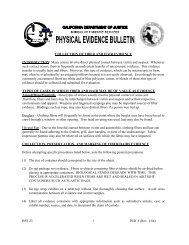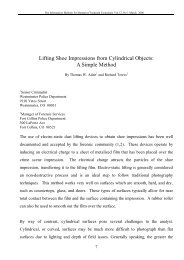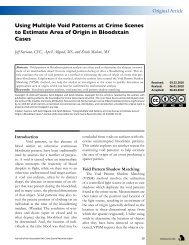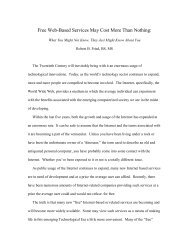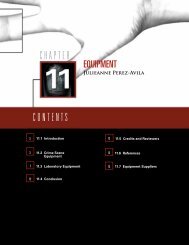PHYSICAL EVIDENCE MANUAL - Crime Scene Investigator Network
PHYSICAL EVIDENCE MANUAL - Crime Scene Investigator Network
PHYSICAL EVIDENCE MANUAL - Crime Scene Investigator Network
You also want an ePaper? Increase the reach of your titles
YUMPU automatically turns print PDFs into web optimized ePapers that Google loves.
Physical Evidence Manual<br />
Chain of Custody<br />
The chain of custody of evidence is very important and the court may require proof that<br />
the evidence presented in court is the same as that collected at the crime scene. A<br />
proper chain of custody offers this proof and maintains the integrity of the evidence by<br />
recording who had contact with the evidence, at what time, and what changes may have<br />
been made to the evidence. By following your police department policy on maintaining a<br />
chain of custody, along with the Forensic Services Division policies on submitting<br />
evidence, you ensure the integrity of the evidence.<br />
Submission of Evidence to your Forensic Laboratory<br />
All sealed evidence should be submitted to your local laboratory. An exception to this is<br />
a case with blood alcohol or toxicology evidence, which can be submitted directly to the<br />
appropriate tox laboratory. For example, although DNA analysis is only performed at the<br />
forensic laboratory in Portland, you should still submit all evidence needing DNA<br />
analysis, including standards, to your local laboratory.<br />
Large and involved cases (such as homicides, sexual assaults, and other violent<br />
crimes) can contain dozens to hundreds of pieces of evidence that require different<br />
types of examinations. The analyst(s) in your local laboratory are trained to manage the<br />
evidence in your case by ensuring that the evidence gets to the appropriate person for<br />
examination. That person may be in another laboratory and the evidence will be<br />
transferred to them without any additional request by you. The analyst(s) that is<br />
managing your case evidence in your local laboratory will be your contact person for<br />
status updates.<br />
Delivery to Laboratory<br />
Sealed evidence may be submitted to the forensic laboratory by one of four methods: hand<br />
delivery (please call for an appointment before delivering to the lab), first class U.S. Mail,<br />
Federal Express, or United Parcel Service (UPS). The Department of Transportation has<br />
Federal Regulations on packing and shipping items. All persons who package, ship<br />
(regardless of the carrier), transport, or receive these items are responsible for following<br />
the Regulations. Title 49 parts 180-185 of the Code of Federal Regulations outlines the<br />
requirements that are to be met.<br />
Some evidence that is shipped to the laboratories is considered hazardous material and<br />
must follow the Code of Federal Regulations. The Oregon State Police Forensic Services<br />
Division is currently developing new policy regarding the packaging and shipment of<br />
evidence to meet these criteria. Once the policy has been adopted, it will be disseminated<br />
to all law enforcement agencies statewide to ensure Federal compliance.<br />
Adopted: May 2002<br />
Revisions: 6<br />
Last Revision: January 31, 2008<br />
4-7



